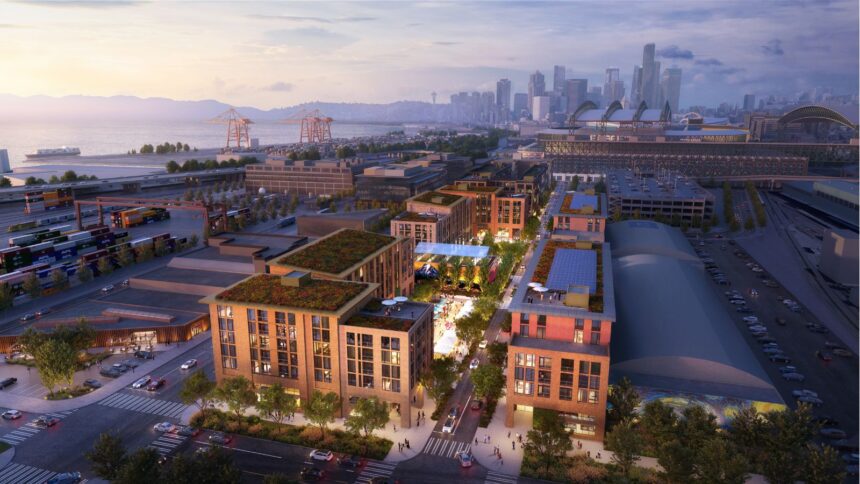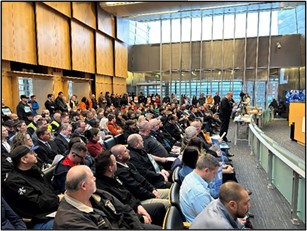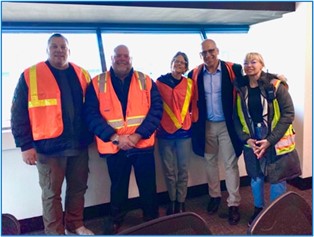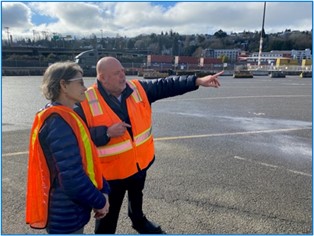Seattle’s in the midst of a housing affordability crisis and small manufacturing businesses are leaving town for lack of affordable commercial space. I’m advancing a widely-supported proposal that will help solve for both at no cost to the City – what’s not to like about that? Learn the facts below.
Council Bill 120933 would allow construction of workforce housing and small commercial spaces for local small manufacturing businesses, generate good union jobs, and improve public safety in a two-block stretch of the Stadium Transition Area Overlay District (or “Stadium District” for short) just south of T-Mobile Park.
Its adoption will pave the way for the creation of what a broad coalition that includes labor, affordable housing providers, the two public stadium authorities and their teams, small businesses and the Pioneer Square and Chinatown-International District neighborhoods call the Stadium Makers’ District.
Background
The portion of SODO (South of Downtown) surrounding the two sports stadiums, known as the Stadium District, was rezoned in 2023. It is located in the newly designated Urban Industrial (UI) zone, which allows residential uses as long as half of that housing is affordable at 60-90 percent of the Area Median Income and built on site. This is the only land use zone in Seattle with an affordability requirement — and it will last for 75 years!
The Environmental Impact Statement that accompanied the 2023 industrial lands rezone analyzed the impacts of almost 1,000 residential units in the Stadium District and found no adverse impacts to Port operations. That’s why housing in the Stadium District was recommended in the Executive’s Preferred Alternative. So, supporters were surprised and disappointed that the legislation transmitted to Council allowed for housing in every UI zone except the Stadium District and the two blocks immediately south of it.
My legislation seeks to correct that omission. It was introduced on Jan. 14 and initially discussed in Council’s Governance, Accountability and Economic Development Committee on Jan. 24, where a panel of proponents explained their support for the proposal.
It cleared an important milestone at the Feb. 27 Governance, Accountability, and Economic Development Committee meeting when it was approved on a vote of three in favor (Councilmembers Rivera, Solomon, and me) and two opposed (Councilmembers Kettle and Hollingsworth). It is scheduled for a full Council vote on March 18.
The Facts
Before my bill was introduced, I met with leaders of the Port and the Northwest Seaport Alliance to hear their concerns about my proposal. In February, I joined them for a tour o f Port facilities with leaders of the Longshore and Warehouse Union Local 19 (Longshore) for a firsthand view (see photos above). The Port and Longshore fear that the vehicles of new residents so close to the waterfront will interfere with trucks moving cargo to and from the terminals, impacting Port operations. But while housing along two blocks of Occidental S/1st Ave. S may bring additional cars, it stretches credulity that such a small increase will make a big difference, given that:
Longshore is opposed to developing these two blocks because housing in the Stadium District violates a core tenet of their national platform which is “no net loss of industrial lands.” They say that no matter where it is, housing in Manufacturing Industrial Centers is an “existential threat” to Longshore jobs.
- Each year 5 million visitors attend games and events at Lumen Field and T-Mobile Park.
- A hotel is planned to be built on the corner of 1st Ave. S and Royal Brougham, a major arterial to I-5 and I-90. The Port agreed to this.
- Current zoning already allows commercial and office development around the stadiums, both of which have a greater impact on traffic than housing. The Port has not expressed concerns about this.
- The 2023 rezone allows for 160-foot towers in SODO’s new Industry and Innovation (II) zone, which will bring a lot of commuter trips along I-5 and I-90 to those offices. The Port didn’t object to that.
- The Port is courting a new operator for Terminal 46, located to the north and across 1st Ave. S from the proposed workforce housing site that would manage both cargo and cruise ships — which would be great for downtown economic development but would add a significant amount of pedestrian and vehicular traffic.
We should not make policy based on fear of existential threats, but rather on facts. And the facts are:
- The EIS traffic analysis determined that housing would not negatively impact freight mobility, which is why the Preferred Alternative recommended housing in the Stadium District.
- There has been very little cargo activity on Terminal 46 for the last five years. The vast majority of cargo enters and leaves the Port of Seattle via Terminal 5 on the eastern flank of West Seattle, north of Delridge.
- Trucks carrying agricultural products from Eastern Washington on I-90 do not travel down 1st Ave. S or Occidental S. They access Terminal 5 via Spokane St. and West Marginal Way. A smaller amount of agricultural cargo uses Harbor Island’s Terminal 18, which would also primarily be accessed by Spokane St. However, if Spokane St. is heavily congested, then trucks might utilize Atlantic Street to get to Alaskan Way and then head south.
- Grain from Eastern WA goes north via I-5 to Mercer to reach Terminal 86 at the base of Queen Anne.
Bottom line, there is NO evidence that freight mobility will be impacted by resident vehicles to the point of directly causing Longshore job loss. In fact, as a result of infrastructure improvements at Terminal 5, cargo volumes are expected to increase, not decrease, in years to come. That will support more, not fewer, Longshore jobs.
These facts reveal that the opponents’ long-stated reasons for blocking housing in the Stadium District just don’t hold water. Yet they’ve been weaponized to instill fear in Eastern Washington farmers that they won’t be able to get their crops to market and to blame supporters of housing in the Stadium District for putting at risk the Port’s future viability and the whole region’s maritime industrial economy.
If that were true, I doubt the 22 locals representing 173,000 union members and Seattle Made’s 700 small manufacturing business members would be backing this proposal. And if the benefits of additional housing during an affordability crisis didn’t clearly outweigh its speculative costs, I doubt the more than 200 affordable housing providers in support of this bill would jump into the political fray. Nor would the Pioneer Square and Chinatown/International District neighborhood associations and two public stadium authorities – all of whom are concerned about public safety in the area – be advocating so strongly for the activation that housing and new small businesses would bring.
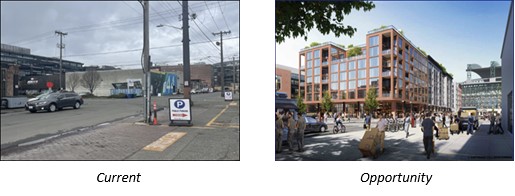
Recently, the Port voiced an environmental justice concern: that the area where workforce housing would be is rated lowest on the city’s “Access to Opportunity Index.” That’s false.
In fact, the map they’re using shows the Stadium District as having a Moderate rating. Georgetown, where the Port/Longshore agreed to housing on industrial zoned land in 2023, has a Low rating.
Then came The Big One concern: people shouldn’t live in areas prone to liquefaction or other geologic hazards.
In fact, all of SoDo, including Georgetown; Pioneer Square; and parts of the Downtown core are prone to liquefaction in the event of a major earthquake and the EIS makes clear that additional development is actually a positive in this regard, because the new structures would be built to seismic standards that would better survive such an event.
Finally, on the eve of the meeting, the Port made a last-ditch effort to derail the legislation by sending a letter threatening to sue the city if the committee took a vote and then staging a press conference an hour before the meeting was to begin. It didn’t work. I issued a release in response to the Port’s allegations, convened the meeting, and the bill was recommended for approval at Full Council on March 18, pending legal analysis from the City Attorney’s Office.
Conclusion
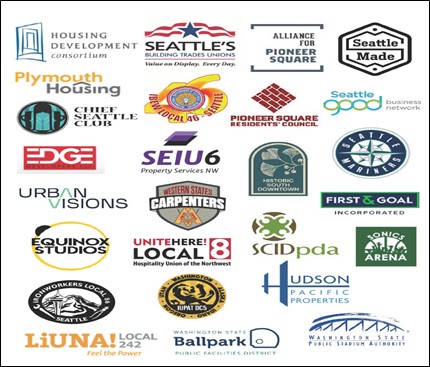
Let me end with this: I have always been a strong ally of the Port and its mission. And as Economic Development Chair, I’m 100 percent committed to championing the maritime industrial sector. So I’d be the last person to advance this legislation if presented with solid evidence demonstrating that adding housing in underutilized parts of SODO would result in the predicted decline in Port activity and jobs. Lacking that, I am proud to advance the vision of the Stadium Makers’ District because I’m convinced it’s the right thing to do for workers, low-income people, struggling small businesses, and the vitality of our evolving City.
# # #


